![]()
![]()
![]()
Use LEFT and RIGHT arrow keys to navigate between flashcards;
Use UP and DOWN arrow keys to flip the card;
H to show hint;
A reads text to speech;
37 Cards in this Set
- Front
- Back
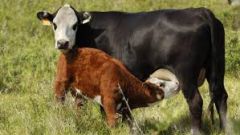
When do most cases of grass staggers occur and mainly in what type of cow? |
Most cases occur at grass in Autumn and spring. Beef cow with a calf at foot. |
|
|
Where is magnesium stored in the body? How are levels of magnesium in the body kept within reference range? |
60-70% in bone. 30-40% in the soft tissues. 1% (2-3g) in ECF. Magnesium has no homeostatic control mechanisms. |
|
|
What is the amount and concentration of magnesium in the ECF dependant on?
|
Absorption of the magnesium from the cows diet. Requirement for magnesium for milk production and other tissues. Excretion by kidneys. |
|
|
What does the amount of magnesium available to the cow depend on? |
1) Intake. 2) Absorption in the gut. 3) Transport to tissues. |
|
|
Name the 2 main magnesium absorption sites in the cow? |
1) Rumen. 2) Omasum. |
|
|
At best how much magnesium is absorbed in the guts? At worst? |
At best: 35% At worst: 10% |
|

What factors influence the availability of magnesium to the cow? |
Soil content, pasture species (clovers and legumes have more magnesium), daily dry matter intake, potassium (decreases Mg), Sodium levels, ammonia, dietary energy, rumen pH, Fats, Genetics |
|
|
What plant species have high levels of magnesium? |
Legumes. Weeds. Herbs. |
|
|
How does potassium impact magnesium availability to the cow? |
High levels of potassium disrupt absorption of magnesium and decrease levels of sodium in the rumen. |
|
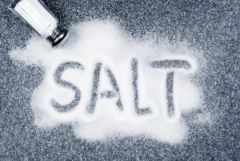
What is needed to carry magnesium across the rumen wall? |
Sodium |
|
|
What is the impact of pH on magnesium availability to the cow? |
Magnesium absorption is reduced by high rumen pH >6.5. |
|
|
What is the effect of high levels of ammonia on magnesium absorption? |
Decrease as ammonia increase the pH. |
|
|
How does dietary energy and fibre influence magnesium absorption?
|
When energy levels in rumen are reduced there is decreased absorption of magnesium. Low in fibre means increased passage of food through rumen so less absorption. |
|
|
What events lead to redistribution of magnesium from the blood to other parts of the body? |
1) Stress. 2) High levels of insulin. |
|
|
What is the onset of clinical signs associated with? |
Onset of clinical signs is associated with magnesium levels in the CSF. |
|

Signs of peracute grass staggers? |
Sudden death with disturbed soil indicative of the animal paddling. |
|
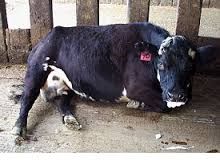
Signs of acute grass staggers? |
Tetanic spasms of the head, neck, legs. Nervousness. Apprehension. Hyperaesthesia. Incordination. Rapid progression to collapse, recumbency, convulsions, coma and death. |
|

Why is it important we minimise stress when treating a grass staggers cow? |
Because stress will lead to convulsions!!!!!! |
|
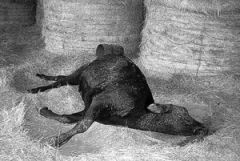
Prognosis for grass staggers? |
30 % of cows die. Some spontaneously recover but relapse is common. |
|
|
Legally in the UK what must we do with all cases of sudden death in cows? |
Report them! |
|
|
Other differentials for grass staggers? |
Hypocalcaemia. Anthrax. Nervous acetonaemia. Meningitis. Listeriosis. Acute lead poisoning. Rabies. BSE. Lightning strike. |
|
|
Signs of subclinical/ chronic grass staggers? |
Depressed milk yields. Nervous cows. Depressed DMI. Hypocalcaemia. |
|
|
Are adult ruminants good at absorbing magnesium? Calves? |
No very poor. Calves are good. |
|
|
How do we diagnose hypomagnesaemia? |
<0.8 mmol/l of magnesium in the blood. 0.4 mmol/l magnesium in acute cases. PMI findings- fresh CSF <0.6 mmol/l Aqueous humor <0.25 mmol/l. |
|
|
How do we treat a cow with grass staggers? |
EMERGENCY, TREAT ASAP, BE CALM. - Blood sample prior- phos, mag, calc levels. - Give her 400 ml 40% calcium borogluconate. - Give 5% magnesium hypophosphite by slow I/V injection. -400 ml of 25% magnesium sulphate by subcutaneous injection, 3-4 seperate sites. Control her convulsions- Pentobarbitone(no Eu), xylazine, ACP. TLC. Ensure adequate DMI. |
|
|
Why must we never give magnesium I/V? |
Will give the cow a fatal heart attack. |
|
|
What is the prognosis for staggers? |
Good if treated early. |
|
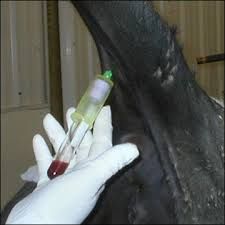
If we have one cow with grass staggers what does it indicate for the rest of the herd? How can we test our herd? |
One cow with grass staggers likely to be subclinical hypomagnesaemia. Blood sample at least 5 cows. |
|
|
What is the daily magnesium requirement of a cow with 10% absorption of magnesium? |
50 g of dietary magnesium |
|
|
What is the daily magnesium requirement of a cow with 35% absorption of magnesium? |
14g of dietary magnesium. |
|
|
On average what is the absorption of magnesium in the GIT for cows? How much magnesium does she need? |
20% usually. 30 grams daily to meet her requirements. |
|
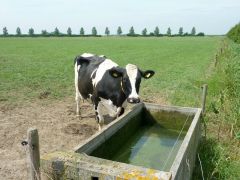
How can we increase the amount of magnesium in a cows diet? |
1) Inclusion in the concentrate ration- aim for 2.5 kg/DM magnesium..Most forage has about 1-2 kg/DM we can increase to meet the 30 gram daily target by mixing the ration with 60 grams of magnesium oxide. 2) Medication of the water. 3) Mineral supplementation. 4) Dusting and spraying of pastures. 5) Intra ruminal boluses. |
|
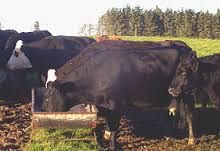
What are problems associated with medicating the water with magnesium? |
All other water sources should be excluded. Medicated water is unpalatable and depresses water intakes. Insufficient daily magnesium for high yielders. Toxicity if the water supply in the trough drops too low or the trough breaks. |
|
|
What are some general preventative measure for grass staggers? |
1) Soil levels - magnesium fertiliser. 2) Pasture species- Clovers, legumes, mixed pasture swards. 3) DMI- avoid sudden diet changes. 4) Minimise the application of potassium. 5) Ensure adequate levels of sodium 6) Controlled use of nitrogenous fertilisers and therefore ammonia. 7) Avoid excess fats- PUFA in spring grass. 8) Adequate fibre and energy 9) Minimise stress. |
|
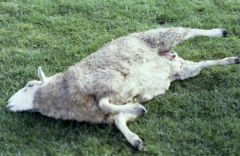
When does grass staggers usually occur in sheep? |
1st 6 weeks after lambing. In ewes with twins. |
|
|
How do we treat a sheep with grass staggers? |
20 mls of warm 20% calcium borogluconate and magnesium I/V 50 Mls magnesium subcutaenously over 3-4 sites. |
|
|
How much magnesium does a sheep need ? |
7 grams of magnesium per ewe per day. |

